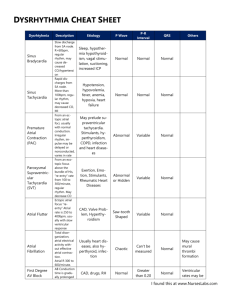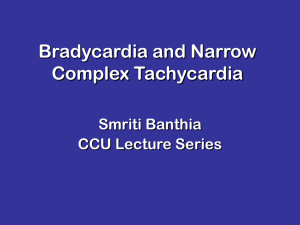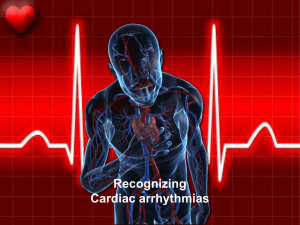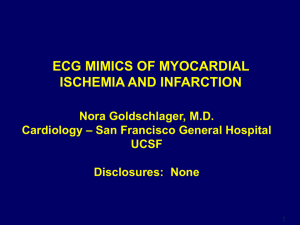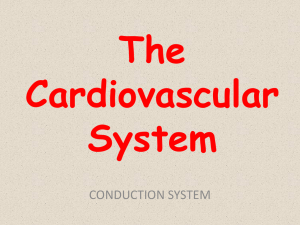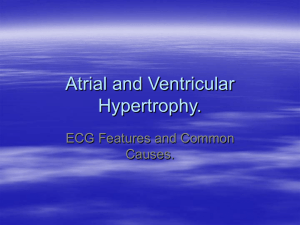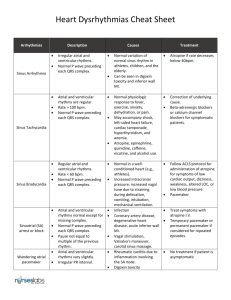Type II
advertisement
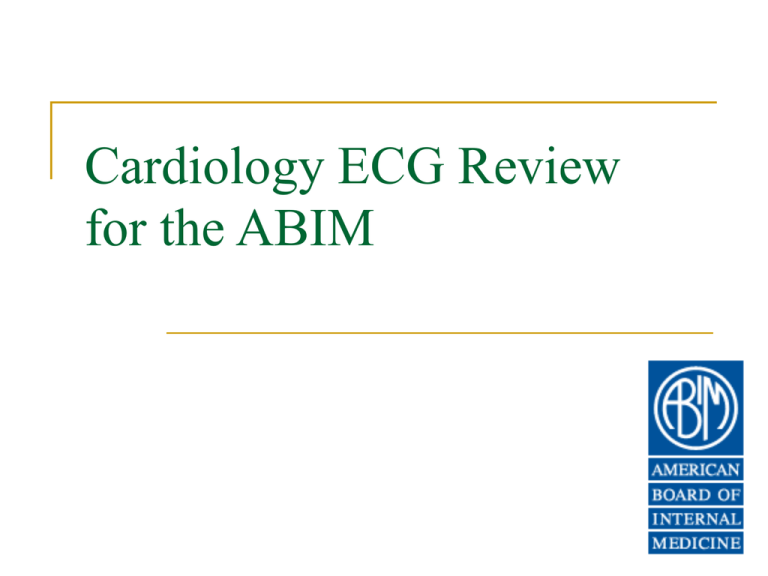
Cardiology ECG Review for the ABIM A 42-year-old man is noted to have a soft S1 on physical examination. Where’s The “P” 2. Look at QRS 3. Assess ST Segment A 72-year-old man with a 35-year history of hypertension is evaluated because of dyspnea. What is LVH? Cornell: Voltage: R wave in aVL + S wave in V3 >20 in ♀, >24 in ♂ R wave in V5/V6 + S in V1 > 35mm Non Voltage Changes: LAA LAD IVCD Asymmetric ST depression + T wave inversion A 72-year-old man is noted to have bradycardia alternating with tachycardia during an orthopedic procedure. ECG Diagnosis Atrial fibrillation (AF) is characterized by: 1. Rapid and irregular atrial fibrillatory waves at a rate of 350 to 600 imp/min 2. An irregularly irregular ventricular response of 90 up to 170 beats/min (Can be higher in some pts) Pitfalls in Diagnosis 1. Fibrillatory waves may be inapparent on the standard and precordial leads. 2. Fibrillatory and U waves may have sufficient amplitude to look like P waves. 3. Extracardiac artifacts (eg, 60 cycle/min muscle tremors as in Parkinsonism) may simulate fibrillatory waves. 4. Regular R-R interval with AV dissociation or block with a lower junctional or ventricular pacemaker assumes control of the ventricles A 65-year-old woman is evaluated because of new-onset atrial fibrillation and an embolic stroke. Echocardiography is performed. What does the echocardiogram show? Spontaneous Echo Contrast Increased RBC aggregation due to altered LAA flow dynamics and uncoordinated left atrial systole Results in smoke-like echoes swirling in LA: SEC or “smoke” presumed to proceeding stage to thrombus formation Seen in 50%- 65% of pts with AF 60-year-old woman with hypertension and diabetes mellitus is evaluated because of an 8-hour history of substernal chest pressure associated with dyspnea and diaphoresis. MI - LOCATION Anteroseptal: V1-3 Inferior: II, III, F Anterior: V2-4, or V1-V6 Anterolateral: V4/5-V6, I, aVL Right Ventricular: ST elevation V4R Posterior: Tall R waves in V1, R/S ratio in V1>1 Normal ST elevation (concave) Early repolarization (concave) Normal variant with terminal T-wave inversion LVH LBBB Acute HyperK+ AS MI Pericarditis Brugada AS RBBB Marriott, NEJM, 2004. A 38-year-old woman is evaluated because of palpitations. She has a childhood history of the acute onset of rapid regular palpitations that she has learned to terminate with different vagal maneuvers. A 12-lead electrocardiogram taken during a period of palpitations is shown. What abnormality is seen? Commonly Encountered SVT Regular Sinus Tachycardia PSVT AVRT AVNRT SART Atrial Flutter PAT Irregular Atrial Fibrillation MAT Sinus Tachycardia with frequent PAC’s Atrial Flutter with variable AV block AVNRT • • Most common SVT Two pathways within the AV node Rates: 120-250BPM Median age: 32+/-18 P waves often buried within QRS complex Inverted P waves in leads I, II, III and aVF Pseudo-r’ waves in V1 AVNRT <70ms A 76-year-old woman with hypertension and paroxysmal atrial fibrillation is seen for a follow-up visit. Current medications are hydrochlorothiazide and digoxin. Digitalis Toxicity Classic combo disturbances: Atrial tachycardia with AV block Regular, accelerated junctional rhythm in AF A 65-year-old man is evaluated because of lower-extremity edema and renal failure. Echocardiography is performed. What does the echocardiogram show? A 75-year-old woman who was treated for heart block 3 years ago is seen for a followup visit. Pacemaker Codes Pacing Systems Pacemaker An 87-year-old man with a pacemaker implanted for atrioventricular block is seen in follow-up. An 80-year-old man underwent implantation of a single-chamber pacemaker for paroxysmal atrioventricular block 3 years ago. He now has a cerebrovascular accident. VVI Mode Responds to a sensed event. Time value remaining in interval deleted Output circuit disabled Interval ends without a paced event Commonly used for patients in chronic AF. VVI Mode (1) (2) (3) (4) Ventricular pacing Ventricular pacing after ventricular escape interval(VV) Ventricular sensed event, no pacing, VV reset Ventricular pacing after reset ventricular escape interval A 60-year-old woman is evaluated because of palpitations. Atrial Flutter Atrial tachycardia typically< 180 bpm AT usually has isoelectric baseline Atrial fluttter rates 240-200 bpm Macroreentrant atrial rhythm with a reentry circuit involving large area of atrium Commonly 2:1 AV conduction Even ratios (2:1, 4:1) much more common than odd ratios (3:1, 5:1) Atrial Flutter Type I or Typical atrial flutter More negative in Lead II Type II atrial flutter More positive F waves inferiorly A 59-year-old man is brought to the emergency department because of substernal chest pressure of 1 hour's duration. Heart Block in MI Inferior MI Anterior MI: A 53-year-old woman is evaluated because of pleuritic chest pain. Classic Evolution in Acute Pericarditis Stage 1: Concave ST segment elevation in almost all leads (no reciprocal ST depression) Stage 2: ST segments decrease and T wave amplitude reduces Stage 3: T waves invert Stage 4: ECG normalizes Acute Pericarditis Look at lead aVR: ST depression PR elevation Sinus Tachycardia PR depression Look for electrical alternans An 84-year-old woman is hospitalized because of acute coronary syndrome. A 74-year-old man with ischemic cardiomyopathy and an implanted cardioverter/defibrillator develops palpitations and presyncope. VT- All favor History: 90% of Ischemic CMP WCT=VT Axis- “northwest/ right superior” QRS Duration: RBBB> 140ms LBBB> 160ms Precordial Concordance (esp negative) AV Dissociation Fusion beats Capture beats A 78-year-old woman is hospitalized because of pyelonephritis. A 50-year-old man with severe ischemic cardiomyopathy is hospitalized because of syncope. Bundle Branch Block QRS> 0.12ms Left: Broad monophasic R wave in leads I, V5, or V6 Leads V1-2 reveal QS or rS pattern Right: Secondary r’ wave in V1 –o ften an M shape Wide slurred S wave in I, V5, and V6 A 60-year-old man with hypertension and an evolving anterior wall myocardial infarction is evaluated in the emergency department. Acquired: Polymorphic VT most commonly precipitated by long-short RR intervals A 45-year-old male smoker is evaluated because of a 3hour history of substernal chest pressure radiating to the left arm associated with nausea and vomiting. A 43-year-old man with congenital heart disease is evaluated because of progressive dyspnea for the past 3 years. RVH Right axis deviation Tall R wave in V1> 7mm, R/S ratio V1> 1 QRS< 120ms S wave in in V5/6> 2mm A 44-year-old woman has hypertension. AVRT AVRT Bypass Tract BPT is concealed, retrograde conduction allows Atrial activation>>AVN conduction>>V activation>> Retrograde BPT conduction>> Atrial activation ….. Bypass Tract Antegrade conduction is evidenced by Delta wave, atrial activation>> BPT conduction>> V activation>> Retrograde AVN conduction >> atrial activation ….. AVRT A 52-year-old man is evaluated because of acute renal insufficiency An otherwise asymptomatic 72-year-old man is evaluated because of an irregular pulse rate detected by his physician. A 55-year-old man is evaluated because of chest pain and hypotension 5 days after sustaining a myocardial infarction. Echocardiography is performed. What does the echocardiogram show? A 22-year-old man is evaluated because of dyspnea. A 74-year-old man is evaluated because of exertional fatigue. Heart Block Complete Heart Block AV dissociation No relationship between P waves and QRS complexes RR is regular Second degree AV block: Mobitz Type II PR remains constant and is either nml or slighlt prolonged Ventricular rhythm is irregular because of nonconducted beats 62-year-old man with hypertension and diabetes mellitus is evaluated because of substernal chest pressure radiating to the neck for the past 35 minutes. A 12-lead electrocardiogram is obtained upon his arrival in the emergency department. A 70-year-old woman with hypertension is seen for evaluation. A 40-year-old woman is evaluated because of headaches and muscle cramps. A 46-year-old woman is evaluated because of palpitations. Her 12-lead electrocardiogram, obtained while she is having typical symptoms. A 74-year-old man with a history of prior myocardial infarction is evaluated because of palpitations.

